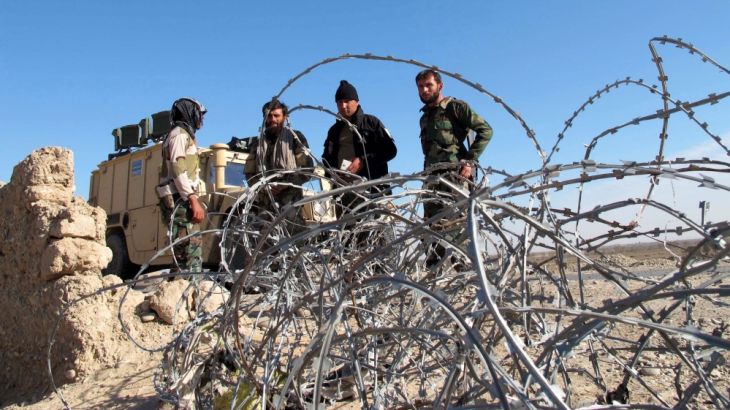Residents stranded as battle for Helmand intensifies
Residents say battle for Sangin district has left them stranded as the clashes continue for the third day.

Residents of Sangin in Afghanistan have told Al Jazeera they are stranded with no food and water supplies as fierce fighting continues between government forces and the Taliban for control of Helmand province.
Atiqullah Rehman, a Sangin resident who wants to flee the area but has been unable to, said that his family had not eaten for the past two days.
Keep reading
list of 4 itemsPhotos: Tourist numbers up in post-war Afghanistan
Taliban ban on girls’ education defies both worldly and religious logic
Afghanistan calls for ‘respect’ after Cricket Australia snub
“Since the Taliban took over the district, all the markets have been shut. Everyone is trying to leave but we cannot step out of our homes,” Rehman told Al Jazeera.
“We might get shot. This is how bad it is here.”
READ MORE: Fierce fight for Helmand as Afghan Taliban gains ground
According to Helmand police chief Abdul Rahman Sarjang, the fighting is ongoing because part of Sangin district is still under Taliban control.
“We [and the Afghan forces] are moving slowly and cautiously to retake the centre of Sangin to avoid civilian casualties,” he told Al Jazeera.
Another man, Esmatullah, managed to flee Sangin with his family of four and said they were now in Lashkar Gah, which is about one hour away by road. They had to leave their belongings at home, he said.
“We don’t know when we will be able to go back home. Maybe not any time soon,” he told Al Jazeera. “In fear of losing our lives or dying of starvation, we had to leave everything behind and move to Lashkar Gah.
“It is not easy for us at the moment, but I have relatives here who are taking care of us.”
When asked about the conditions for civilians in Sangin, Mohammad Jan Rasoolyar, Helmand’s deputy governor, admitted that the situation was critical.
“We are helpless when there is war going on,” he told Al Jazeera.
“We are trying our best to make sure they are provided with basic necessities like food and water. It is our responsibility, but there is not much we can do at the moment. We are desperately waiting for the situation to get under control. Once it is, we will make sure to support the residents in any possible way.”
Much of Sangin district fell to the Taliban just a day after Rasoolyar used Facebook to plead with Afghan President Ashraf Ghani for help in holding off the group.
READ MORE: Afghans fear the rising influence of Taliban
The UK Ministry of Defence said on Tuesday that British troops had been deployed to the province to support local forces, but that they would have no combat role.
“As part of the UK’s ongoing contribution to NATO’s Resolute Support Mission, a small number of UK personnel have been deployed to Camp Shorabak in Helmand Province in an advisory role,” a spokesman said.
“In total the UK has around 450 troops in Afghanistan mentoring and supporting the Afghan National Defence and Security Forces and the Afghan Security Ministries.”
The northern city of Kunduz briefly fell to the Taliban in late September – the biggest victory for the group in 14 years of war.
US President Barack Obama announced in October that thousands of US troops would remain in Afghanistan past 2016, keeping the current force of 9,800 troops, amid a surge in Taliban attacks.
|
Why is the Taliban making gains? Analysis from Al Jazeera’s Hashmatallah Moslih Usually in an armed conflict when governments negotiate peace with their enemy they do so by taking the fight to them while, at the same time, negotiating peace and gaining more concessions. But in Afghanistan it is the other way round. There, the Taliban, who have been fighting the Afghan government and its international backers – namely, the US – for more than a decade, are taking the fight to the government with significant gains. Why? Since disputed elections in mid-2014 and subsequent power-sharing, the government has put its National Defence Security Forces (NDSF) on the defensive while it is busy implementing the power-sharing deal and talking peace with the Taliban using the Pakistani government as an intermediary. The NDSF is strong, with both manpower and firepower. But it lacks strategic political leadership and air power, and this has been exploited by the Taliban. Recently, the Taliban has shown an extraordinary capability to launch major attacks on government forces. They have proven capable of using both guerrilla fighters and engaging in conventional warfare. At the same time, the government soldiers are static – sitting in their outposts defensively, effectively handing the initiative to the Taliban. This situation has come about because of a lack of strategic vision on the part of the government. It wants peace but it has no overarching war and peace strategy. But the Taliban does. It is fighting its way to the peace table as a potent force asking for more concessions from the government. This latest offensive in Sangin is part of that. Helmand has produced more Taliban fighters than any other province in the country and at times has even been referred to as Talibanistan. It is also one of the major opium-producing regions, a good source of revenue should it fall to the Taliban. |